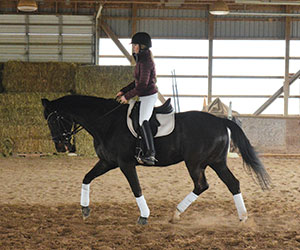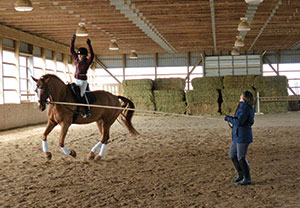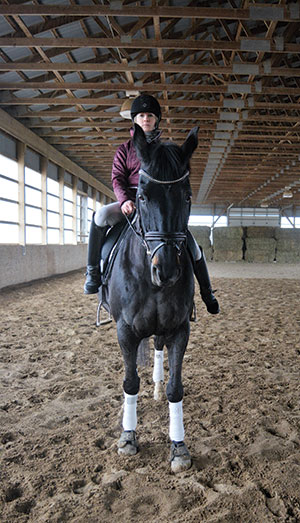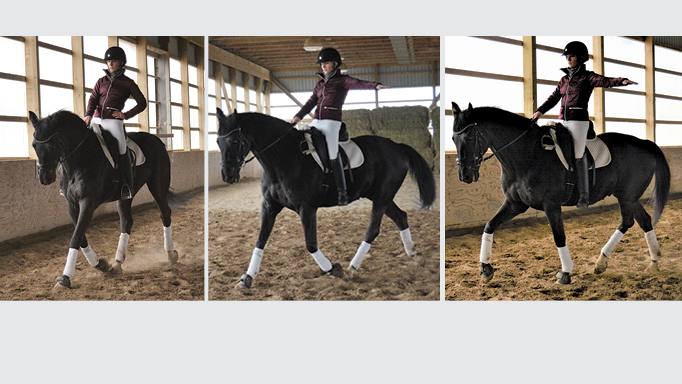When ridden well, dressage looks so easy that it is tempting to overlook the amount of balance and core strength required to create that effortless appearance: tall in the saddle, long quiet legs, a deep seat, and nearly invisible aids.
Debbie Dobson understands the struggle many riders face in trying to achieve that balance. With a lifetime of experience as a rider and trainer, and more than 20 years operating Equestrian Dreams near Campbellvile, ON, Dobson emphasizes rider biomechanics in her lesson program to help clients achieve their goals. While overall rider fitness is essential and she recommends yoga, Pilates, and working with a personal trainer out of the saddle, Dobson shared a number of simple yet effective mounted exercises that can be done by riders of all levels to improve balance and create a deep, independent seat.
All of these exercises can be done on a lunge line with a safe, reliable horse. More advanced riders can also practice those that don’t require dropping the reins off the lunge line as well.
Novice riders should be doing these exercises under supervision at least once a week until they are comfortable riding with no reins and no stirrups. More advanced riders can incorporate some of the exercises every time they ride, for instance, in the warm up. For this level Dobson recommends a formal lunge lesson with an instructor once a month as a tune-up.
Position Check
Holly Broughton-Holtze demonstrates with Danseur, a 21-year-old Oldenburg, that when she is hollow/concave in her back it makes Danseur hollow in his back.
Here Holly demonstrates the opposite problem, and is concave through her abdomen. Debbie advises her to bring the shoulders more forward and bear down more with her body, pushing her ab muscles out towards her front, back and sides to create a stronger, more influential upper body. With these corrections the rider will be able to let go more with the legs and not grip.
After making the corrections Holly is more upright and balanced, allowing her lower leg to relax and ‘breathe’ with the horse.

Holly stays out of the saddle for two beats of the trot, while not using her hands to help her rise or stay balanced. Note her leg remains long and still, her posture straight and her eyes looking ahead, not down.
1. FEEL THE RHYTHM: Posting Exercise
A. Changing your posting rhythm is a great way to improve balance and feel for the horse’s rhythm. Begin by sitting a few strides at a time – instead of “up, down, up, down” try “up, down, down, down, up, down, down, down.” This is an excellent exercise for learning or improving the sitting trot. As you get more balanced, increase the number of sitting strides.
B. A harder variation is to post two or three strides at a time. Try “up, up, down” and see if you can stay up out of the saddle for two beats without losing balance or falling back into the saddle. Increase the number of strides out of the saddle as you get stronger. You should feel the muscles in your abdomen really working to keep you balanced over the horse.
C. When you’re ready to kick it up another notch, Dobson recommends trying this exercise without stirrups, and/or without reins.

Raising both arms over her head forces Holly to sit deeply in the saddle and remain upright through her body for balance.
2. LOOK MA, NO HANDS!: Arm Exercises
Riding without reins is the best way to create a truly independent seat and to teach riders not to use their hands for balance. For safety reasons these exercises should be performed on the lunge line with the help of an experienced handler. They can all be performed at the walk, trot, and canter, depending on the comfort and skill level of the rider, and with or without stirrups for an added level of difficulty.
A. Arm circles can be performed one or both arms at a time, forwards, backwards, and – for the truly coordinated – with one arm circling forward while the other circles in the opposite direction. This exercise not only requires balance, but also helps train your brain to multitask – an essential skill for dressage riders who need to isolate what different parts of the body are doing in order for the hands, legs, and seat to each work independently. Dobson suggests riding for several strides with your arms in different positions – on your hips, straight in front, overhead, out to the sides, and out behind – to feel how your balance chances and how you adjust your weight in the saddle accordingly.
B. Imagine you are holding a large beach ball in your arms, directly in front of your body. Try not to drop or squish your imaginary ball as you move from walk to trot, posting to sitting tot, and trot to canter. This exercise teaches riders to stay open through the upper body without collapsing through the chest and mid-section. Think about leading with your belt buckle in each stride to activate and stabilize the core muscles.
C. Imagine you are juggling two small balls – one in each hand. Alternately raise and lower each hand while maintaining the rhythm of the rising trot. Can you maintain the rhythm of your hands while changing your posting rhythm (up, down, down, up)? What about at the canter? This tricky task is a great way to work on rider balance while creating hands that function independently.

Alternately raising and lowering each leg as if she’s pedalling a bike helps loosen Holly’s hip flexors, allowing her to sit more deeply in the saddle with her leg hanging straight underneath her.
3. IT’S LIKE RIDING A BICYCLE: Loosen Back + Hips
Many riders struggle with sitting deeply and relaxing their legs due to tightness in the hips and lower back, often resulting in bouncing in the saddle and gripping or creeping up with the legs. The bicycle exercise is a great way to loosen tight hip flexor muscles and create more flexibility in the lower back, a requirement for sitting deeply and absorbing the motion of the horse. At the halt or walk, alternately raise and lower each leg as if you are pedalling a bike. Dobson says to concentrate on maintaining good posture and not leaning side-to-side or using the reins for balance as you “pedal.”
4. QUIET PLEASE: Hand Stabilizing
It’s easy for riders to balance on the reins without even being aware they are doing so. The classic Pony Club trick of holding a crop horizontally while holding the reins is a favourite of Dobson’s to quiet the hands, forcing the rider to activate their core muscles for stability and creating awareness of how their hands are being used.
Safety First
Safety should always be paramount, but particularly when riding on a lunge line, without stirrups and/or without reins.
- Lunge lessons are best suited for a well-trained, reliable horse with steady, easy-to-sit gaits and an experienced handler on the ground.
- Side reins should be attached and adjusted correctly after the rider has mounted.
- When not being used, stirrups should be crossed over the front of the saddle or removed entirely.
- When not being used, reins should be knotted and looped through a grab handle attached to the front of the saddle. This ensures they are safely secured, yet still accessible to the rider in case of emergency.

